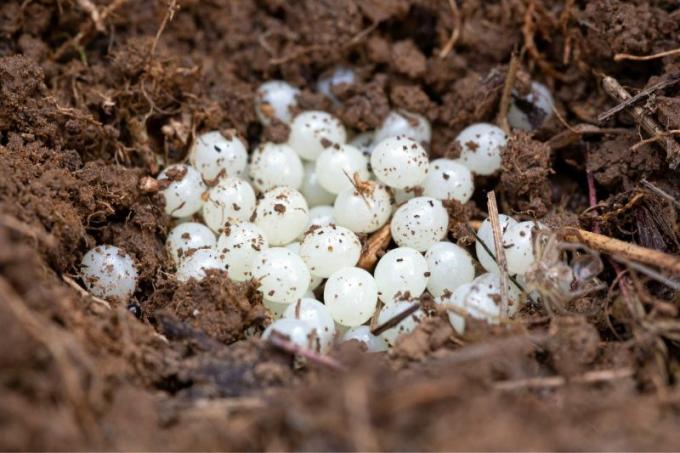
The Tagetes originally comes from Mexico and is not hardy. It is primarily cultivated as an annual bedding or balcony plant. It is possible for some varieties to overwinter because the Tagetes is perennial.
To the point
- only vital plants overwinter
- Remove flowers
- Repot into substrate that is not too nutrient-rich
- Winter quarters must be warm and bright
- Do not fertilize in winter and only water moderately
Table of contents
- Annual or perennial
- Prepare marigolds
- Repotting
- Location in winter
- Care in winter
- Pests and diseases
- frequently asked Questions
Annual or perennial
Some Tagetes varieties are perennial but not winter hardy. Due to the fact that marigold flowers, as marigolds are also called, can be easily propagated by sowing, it is rarely stated whether a multi-year culture is possible. This means you can only try to overwinter the plant if you have a particularly beautiful specimen in the bed or in balcony boxes.

So that you don't try to overwinter plants that have little chance of overwintering, you should choose healthy and vital specimens.
Tagetes should have the following characteristics for overwintering:
- strong and undamaged main shoots
- healthy green foliage
- free from pests and diseases
The marigolds can occasionally be attacked by leaf miner fly species. You can simply remove affected leaves with light-colored veins and still let the plants overwinter.
Prepare marigolds
As soon as temperatures drop below 10°C, you can start preparing the marigolds for overwintering. Check the plant to see whether it is healthy and vital.
In winter there is not enough light for the plant to continue blooming. Therefore, remove flower buds and flowers as well as any fruit clusters that have formed early. This allows the plant to save a lot of energy that it needs for overwintering.
Repotting
Even if the marigold is already in a pot, you should remove the plant and check whether there is any substrate, for example grubs or other pests have nested. They can cause lasting damage to the roots of the marigold in winter quarters, which could cause it to die.
You should repot outdoor plants in good time. On average, it takes two weeks for plants to form new roots and become well-rooted after being transplanted. You don't need fresh substrate for this; it is sufficient if you lift the plant directly from the ground and place it in the pot. If you have to replace substrate, use soil with as few nutrients as possible. For example, mix potting soil with potting soil so that the plants don't go into the winter with too many nutrients.
Too high a nutrient content would lead to shoot formation in winter. This costs the plant a lot of energy and the shoots would usually only grow poorly because they lack the necessary light.
Repot marigolds correctly:
- Cut out plants with root balls twice the size
- Prepare a pot with expanded clay drainage
- Place plants carefully in the pot
- Possibly. fill with some substrate
- pour on

In order to estimate the correct size of the root ball and to injure as few fine hair roots as possible, you can use the diameter of the clump plus 5 to 10 cm as a rule of thumb.
Location in winter
Before the first day of frost, the non-hardy marigold must move to its winter quarters. Often the plants have already suffered a light frost but still look fresh and green. The frost damage only becomes apparent after a few days when the leaves become soft and mushy. Therefore, do not wait too long to take them to their winter quarters.
In winter the marigold likes it warm, which has the advantage that it can be cultivated like a houseplant. The room should have a temperature of at least 15 °C, ideally 20 °C. The place should be bright. In winter it tolerates a location directly in a sunny window. You should avoid a place directly above a heater. The marigolds like it very warm, but the dry air from the heating can lead to brown spots on the leaves.
Care in winter
In winter, you can completely avoid fertilizing the Tagetes, which is not hardy. In addition, the Tagetes may only be watered moderately. The substrate should always be slightly moist, but not wet.
If there are longer periods of sunshine in winter, the plants may develop new flower buds. Remove the buds as early as possible so that the marigold does not spend unnecessary energy blooming.
Pests and diseases
The marigold itself is not very susceptible to pests and diseases. Only at snails she is very popular. Therefore, when you repot the marigold, be careful not to accidentally bring small snails into the house.

When watering, make sure that no waterlogging forms. Standing water damages the roots, causing them to die. The plant can then no longer take care of itself and also dies. Always pour out any excess water that collects in the saucer.
frequently asked Questions
Yes, almost all species, even if they are hybrid varieties, can be propagated via seeds. To do this, allow one to two flowers to mature per plant. This doesn't cost the plant much energy and it produces more flowers. If the seed heads are gray and dry, you can remove them.
If your marigolds did not survive the winter, you can use them indoors from March Start pre-culture. From the end of April you can sow directly outdoors.
No, you do not have to cut the plants back. It is sufficient if you remove inflorescences before moving to winter quarters. Only damaged shoots or dead leaves are removed.



